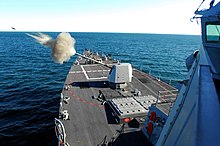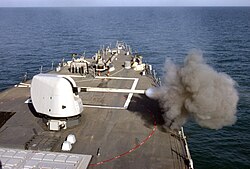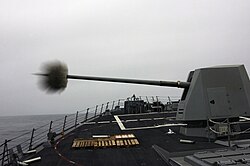5-inch/54-caliber Mark 45 gun
| Mark 45 5-inch/54-caliber lightweight gun | |
|---|---|
 5-inch/62-caliber Mark 45 Mod 4, in flat-panel gun turret, test firing on USS Forrest Sherman | |
| Type | Naval gun |
| Place of origin | United States |
| Service history | |
| In service | 1971–present |
| Used by | See Operators |
| Production history | |
| Designed | 1968[1] |
| Manufacturer | United Defense[1] (now BAE Systems Land & Armaments) |
| Produced | 1971[1] |
| Specifications (Mod 2) | |
| Mass | 21,691 kg (47,820.5 lb)[1] |
| Length | 8.992 m (29 ft 6.0 in)[3] |
| Barrel length | 6.858 m (22 ft 6.0 in)[3] Rifling: 5.82 m (19 ft 1 in)[3]
|
| Shell | 127 × 835 mm .R Conventional: 31.75 kg (70.0 lb)[1] |
| Caliber | 54 caliber |
| Elevation | |
| Traverse | |
| Rate of fire | 16–20 rounds per minute automatic[4] |
| Muzzle velocity |
|
| Effective firing range | 13 nmi (24.1 km)[4] or 20 nmi (37.0 km) (Mod 4)[5] |
The 5-inch (127 mm)/54-caliber (Mk 45) lightweight gun is a U.S. naval artillery gun mount consisting of a 5 in (127 mm) L54 Mark 19 gun on the Mark 45 mount.[1] It was designed and built by United Defense, a company later acquired by BAE Systems Land & Armaments, which continued manufacture.
The latest 62-calibre-long version consists of a longer-barrel L62 Mark 36 gun fitted on the same Mark 45 mount.[1] The gun is designed for use against surface warships, anti-aircraft and shore bombardment to support amphibious operations.[1] The gun mount features an automatic loader with a capacity of 20 rounds. These can be fired under full automatic control, taking a little over a minute to exhaust those rounds at maximum fire rate. For sustained use, the gun mount would be occupied by a six-person crew (gun captain, panel operator, and four ammunition loaders) below deck to keep the gun continuously supplied with ammunition.
History
[edit]Development started in the 1960s as a replacement for the 5-inch (127 mm)/54-caliber Mark 42 gun system that had debuted in 1953 with a new, lighter, and easier-to-maintain gun mounting. The United States Navy uses the Mark 45 with either the Mk 86 Gun Fire Control System or the Mk 34 Gun Weapon System. Since before World War II, 5 inches (127 mm) has been the standard gun caliber for U.S. Naval ships. Its rate of fire is lower than the British 4.5 in (114 mm) gun, but it fires a heavier 5-inch (127 mm) shell which carries a larger burst charge that increases its effectiveness against aircraft.
Variants
[edit]Mod 0
[edit]Used mechanical fuze setter. Two-piece rifled construction, with replaceable liner
Mod 1
[edit]Electronic fuze setter replaces the mechanical one. Made with a unitary construction barrel, which has a life span approximately twice that of the Mark 42 gun.
Mod 2
[edit]Export version of Mod 1, but now used in the U.S. Navy
Mod 3
[edit]Mod 2 gun with a new control system; never put into production
Mod 4
[edit]Receives a longer 62-caliber barrel (versus Mod 1 and 2's 54 caliber) for more complete propellant combustion and higher velocity[6] and thus more utility for land attack. Was designed to use the Mark 171 Extended Range Guided Munition (ERGM), which was canceled. The Mk 45 mod 4 uses a modified flat-panel gun turret, designed to reduce its radar signature.
In sustained firing operations (Mode III), the gun is operated by a six-person crew: a gun captain, a panel operator, and four ammunition loaders, all located below decks. In fully automatic non-sustained firing operations (Mode IV), 20 rounds can be fired without any personnel inside the mount, using an autoloader.
Ammunition
[edit]Mark 68 HE-CVT
- Weight – 68.5 lb (31.1 kg)
- Projectile Length – 26.1 in (66.3 cm)
- Used only with Mods 0–2
Mark 80 HE-PD
- Weight – 67.6 lb (30.7 kg)
- Projectile Length – 26 in (66 cm)
Mark 91 Illum-MT
- Weight – 63.9 lb (29.0 kg)
- Projectile Length – 26.1 in (66.3 cm)
Mark 116 HE-VT
- Weight – 69.7 lb (31.6 kg)
- Projectile Length – 26 in (66 cm)
Mark 127 HE-CVT
- Weight – 68.6 lb (31.1 kg)
- Projectile Length – 26 in (66 cm)
Mark 156 HE-IR
- Weight – 69.0 lb (31.3 kg)
- Projectile Length – 26 in (66 cm)
Mark 172 HE-ICM (Cargo Round)
Guided shell
[edit]This section needs to be updated. (April 2022) |
On 9 May 2014, the U.S. Navy released a request for information (RFI) for a guided 5-inch (127 mm) round that could be fired from Mark 45 guns on Navy destroyers and cruisers. This RFI came six years after the cancelation of the Raytheon Extended Range Guided Munition. The shell must have at least double the range of unguided shells for missions including Naval Surface Fire Support (NSFS)/Land Attack, and increasing anti-surface warfare (ASuW) capabilities against fast attack craft (FAC) and fast inshore attack craft (FIAC); the main purpose is to destroy incoming small boats at a greater range with a proximity fuse airburst blast fragmentation warhead to spray shrapnel over swarms.
Expected submissions include the BAE Systems Multi Service–Standard Guided Projectile (MS-SGP), Raytheon Excalibur N5, and OTO Melara Vulcano guided long-range projectile.[7][8]
Naval Sea Systems Command is also looking to fire a version of the hyper-velocity projectile (HVP) developed for Navy electromagnetic railguns from conventional 5-inch deck guns. Using the HVP could give existing destroyers and cruisers better ability to engage land, air, and missile threats and allow more time to refine the railgun. The HVP would be a cheaper solution to intercepting incoming missiles than a missile interceptor costing hundreds of thousands of dollars. Converting the HVP to fire from conventional guns was not a program of record as of 2015[update].[9] HVP shells fired from 5-inch deck guns would travel at Mach 3, half the speed of a railgun but twice the speed of conventional rounds.[10] The rounds would be more expensive than unguided shells but cheaper than missile interceptors, and engage air and missile targets out to 10–30 nautical miles (12–35 mi; 19–56 km).[11] During 2018 RIMPAC exercises, the USS Dewey (DDG-105) fired 20 HVPs from a standard Mk 45 deck gun; an HVP shell could cost US$75,000-$100,000, compared to $1-$2 million for missiles.[12]
The HVP was renamed to the Gun-Launched Guided Projectile (GLGP) for the Electromagnetic Railgun project.[13] In 2022, the United States Department of the Navy terminated the GLGP Research and Development effort.[14][15]
Operators
[edit]


Current operators
[edit]- Royal Australian Navy
- Anzac-class frigate: Mod 2 (upgraded Mod 2 versions fitted with a Common Control System.[16])
- Hobart-class destroyer: Mod 4
- Hellenic Navy
- Hydra-class frigate (MEKO 200 HN)
- Japan Maritime Self-Defense Force
- Mogami-class frigate: Mod 4
- Atago-class destroyer: Mod 4
- Maya-class destroyer: Mod 4
- Akizuki-class destroyer: Mod 4
- Asahi-class destroyer: Mod 4
- Republic of Korea Navy
- Sejong the Great-class destroyer: Mod 4
- Chungmugong Yi Sun-sin-class destroyer: Mod 4
- Incheon-class frigate: Mod 4
- Royal Thai Navy
- Naresuan-class frigate: Mod 2 (Currently upgraded to Mod 4)
- Turkish Navy
- Barbaros-class frigate (MEKO 200 TN II)
- Yavuz-class frigate (MEKO 200 TN I)
- United States Navy
- Active service ships:
- Ticonderoga-class cruiser: Mod 2[4]
- CG-52-73: Mod 4 after receiving the cruiser modernization
- Arleigh Burke-class destroyer:
- Ticonderoga-class cruiser: Mod 2[4]
- Decommissioned:
- Active service ships:
Future operators
[edit]- Royal Australian Navy
- Hunter-class frigate: 6 ships ordered[17]
- Royal Navy
- Type 26 frigate: 8 ships ordered, 3 in build (Mod 4)
- Turkish Navy
- TF2000-class frigate: 8 in planned
Cancelled deals
[edit]- Indian Navy: The mod 4 variant was previously planned to be deployed on 7 Nilgiri-class frigate and 4 Visakhapatnam-class destroyer. The procurement of 13 guns was cleared by the Indian Ministry of Defence on 27 April 2018. Of the guns, 11 would be deployed on the above-mentioned ships while the rest of 2 would be in INS Dronacharya missile and gunnery school, and INS Valsura electrical and weapons engineering school.[18] The US Defense Security Cooperation Agency cleared under the Foreign Military Sales for the same deal in 2019. The deal would be worth over $1 billion.[19] However, by 2021, India moved on to the development of an indigenous gun of similar calibre due to cost and logistics factor. Till the completion of the development, the 11 destroyers and frigates would be fitted with already operational OTO Melara 76 mm naval gun. The 13 gun deal for the Indian Navy did not go through.[20]
See also
[edit]- Extended Range Guided Munition: long range (~60 nautical miles (110 km; 69 mi)) precision guided projectile program by Raytheon for the Mark 45 gun, canceled in 2008
- Advanced Gun System: The 155 mm (6 in) gun on Zumwalt-class destroyers (unusable; no ammunition)
Weapons of comparable role, performance and era
[edit]- Otobreda 127/54 Compact and Otobreda 127/64: contemporary 127 mm naval gun from Italian manufacturer Oto Melara
- 4.5 inch Mark 8 naval gun: contemporary standard naval gun for British ships
- AK-130: contemporary 130 mm twin standard naval gun mounting for Russian ships
- H/PJ-38 130mm naval gun : contemporary 130 mm standard naval gun mounting for Chinese ships
- French 100 mm naval gun: contemporary standard naval gun for French ships
References
[edit]Notes
[edit]- ^ Jump up to: a b c d e f g h i j k l Norman Polmar, pp. 492–493
- ^ Jump up to: a b "United States of America 5"/54 (12.7 cm) Mark 45 Mod 4". NavWeaps.Com. 18 April 2010. Archived from the original on 2 January 2015. Retrieved 24 October 2010.
- ^ Jump up to: a b c d e f g h "United States of America 5"/54 (12.7 cm) Mark 45 Mods 0–2". NavWeaps.Com. 18 September 2007. Archived from the original on 3 January 2015. Retrieved 24 October 2010.
- ^ Jump up to: a b c d e "The US Navy Fact File: 5-inch Mark 45 54-caliber lightweight gun". United States Navy. 20 February 2009. Archived from the original on 5 December 2010. Retrieved 24 October 2010.
- ^ "Mk 45 Mod 4 Naval Gun System". BAE Systems. Retrieved 15 March 2020.
- ^ "5-inch 62-Caliber Mk 45 Mod 4 Naval Gun System" (PDF). Brochure. BAE Systems. Archived from the original (PDF) on 25 April 2012. Retrieved 5 October 2011.
- ^ Navy Taking a Second Look at A Five-Inch Guided Round Archived 9 June 2014 at the Wayback Machine – News.USNI.org, 3 June 2014
- ^ Navy seeks guided deck-gun shell – Navytimes.com, 4 June 2014
- ^ Navy Researching Firing Mach 3 Guided Round from Standard Deck Guns Archived 1 June 2015 at the Wayback Machine – News.USNI.org, 1 June 2015
- ^ The Future of the Navy's Electromagnetic Railgun Could Be a Big Step Backwards Archived 16 July 2016 at the Wayback Machine - Popularmechanics.com, 6 June 2016
- ^ Pentagon: New Rounds For Old Guns Could Change Missile Defense for Navy, Army Archived 19 July 2016 at the Wayback Machine - News.USNI.org, 18 July 2016
- ^ Navy Quietly Fires 20 Hyper Velocity Projectiles Through Destroyer's Deckgun Archived 9 January 2019 at the Wayback Machine. USNI News. 8 January 2019.
- ^ "USA 5"/62 (12.7 cm) Mark 45 Mod 4". NavWeaps. 21 December 2022. Retrieved 5 October 2024.
- ^ Seck, Hope (4 June 2021). "It May Be the End of the Line for the Navy's Hypervelocity Projectile". Military.com. Retrieved 5 October 2024.
- ^ "Highlights of the Department of the Navy FY 2022 Budget" (PDF). Secretary of the Navy. p. 12-3. Archived from the original (PDF) on 9 June 2021. Retrieved 5 October 2024.
- ^ https://www.australiandefence.com.au/defence/sea/bae-to-install-mk-45-systems-for-navy
- ^ Seidel, Jamie (2 July 2018). "Australia's Hunter class Type 26 frigates explained". News.com.au. Archived from the original on 1 March 2019. Retrieved 18 March 2019.
- ^ "DAC Approves Capital Acquisition Proposals Worth Rs 3,687 Crore". Press Information Bureau. 27 April 2018. Retrieved 18 September 2024.
- ^ Philip, Snehesh Alex (21 November 2019). "Ghost of Finmeccanica behind it, Indian Navy to finally get its big guns as US steps in". ThePrint. Retrieved 18 September 2024.
- ^ Snehesh, Alex Philip. "Navy to scrap plans to procure guns from US, considering 'Make in India' route now". ThePrint. Archived from the original on 2 August 2021.
Bibliography
[edit]- Norman, Polmar (2005). The Naval Institute guide to the ships and aircraft of the U.S. fleet (18th ed.). Annapolis, MD: Naval Institute Press. pp. 492–493. ISBN 978-1-59114-685-8.
External links
[edit]- US Navy Fact File – 5"/54 caliber Mark 45 gun Archived 5 December 2010 at the Wayback Machine
- BAE Systems: Mk 45 Mod 4 Naval Gun System
- BAE Systems: Mk 45 Naval Gun Overhaul and Upgrade
- NavWeaps.Com: 5"/54 (12.7 cm) Mark 45 Mods 0 – 2
- NavWeaps.Com: 5"/62 (12.7 cm) Mark 45 Mod 4
- FAS: Gunner officer information sheet
- BAE Systems' computer animation and video of the Mk 45 Mod 4 gun on YouTube
- Test firing of a Mk 45 5-inch gun by the USS Sterett


